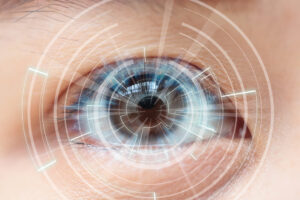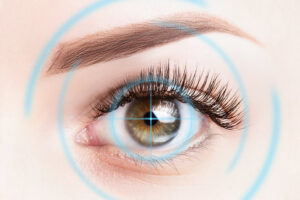
Generally, experts define a cataract (or cataracts) as a clouding on the otherwise clear lens of the eye. Those patients affected by cataracts usually describe their vision as looking through fogged-up frosty windows through their cloudy lenses. Needless to say, cloudy vision caused by cataracts can make simple everyday tasks, like driving a car, reading, or seeing facial expressions, a massive challenge.
While the early signs of cataracts might not appear overly concerning to people, every symptom should be evaluated. Even though the condition won’t interfere excessively with one’s eyesight early on, in time, cataracts will cause vision problems, calling for treatment options such as cataract surgery.
In this article, the expert team at Diamond Vision will talk about the early signs of cataracts, the types of cataracts, and their formation process, assess risk factors, and discuss cataract prevention. That said, if you have any questions or concerns after reading the article, feel free to reach out to us.
Cataract Development
As mentioned at the beginning of this article, a cataract probably won’t cause concerns early on. It’s a progressive condition, meaning that it will take some time to cause more profound vision problems. When asked what the first signs of cataracts are, experts will point out that sensitivity to light or glare may be some telltale signs. On the other hand, the cloudiness may only affect a smaller portion of the eye at first. Generally, this can be one of the most obvious signs of cataracts. Fortunately, corrective eyewear and stronger lighting may help deal with the condition at first. Still, cataract surgery may be required if impaired vision worsens the patient’s enjoyment of everyday activities. Luckily, the latter procedure is effective and safe.
Cataract Symptoms

The most prevalent symptoms of cataracts will usually include the following:
- Blurred, dim, or clouded vision
- Sensitivity to glare and light
- Typically seeing “halos” around lights
- Difficulty seeing at night
- Double vision on a single eye
- Colors may appear to fade or yellowing
- Reading and other activities require a brighter light
- The need to change contact lenses or eyeglass prescription often
As mentioned above, the cloudiness may only affect a small part of the eye’s lens, and the condition may not be apparent. However, as the cataract grows, it will dim more of the eye’s lens and distort the light that passes through it, leading to more profound symptoms.
This is why it’s essential to book an appointment with your doctor right away if you are experiencing the first potential signs of cataracts. This is especially true if the vision changes are sudden and you are experiencing sudden eye pain, headaches, flashes of light, or double vision.
Cataract Causes
Most cataracts result from aging or injury to the eye that alters the tissue that constitutes the eye’s lens. The lenses’ fibers and proteins can start to break down, resulting in cloudy and hazy vision.
On the other hand, inherited genetic disorders that contribute to the development of other health problems may also increase the risk of cataracts. They may also occur as a consequence of long-term steroid medication use. Lastly, other eye conditions, diabetes, and even past eye surgeries may also contribute to cataract development.
How Do Cataracts Form?
Basically, cataracts are cloudy lenses. The lens can be found behind the eye’s colored part, i.e., the iris. The lens’ job is to focus the light that passes into the eye, producing sharp and clear images on the retina, or the eye’s light-sensitive membrane that acts like the film in cameras.
With age, these lenses become less flexible, thicker, and less transparent. The fibers and proteins may start to break down and clump together, which can lead to clouding.
And as cataracts continue to grow, the clouding becomes more apparent. Cataracts block and scatter the light trying to pass through the lens, preventing the retina from reconstructing sharp and defined images, resulting in blurry vision.
The condition will typically develop in both eyes. Still, they may grow at different rates, meaning that the cataract may be more developed in one eye than in the other, causing bothersome vision differences between the eyes.
Cataract Types
Cataracts can typically be:
- Nuclear cataracts affect the lens center. Typically, these can cause temporary reading vision improvements or nearsightedness. However, as the condition progresses, the eye’s lens will turn more yellow, further clouding the patient’s vision. The cataract may even turn brown, and patients may find it challenging to distinguish between different color shades in advanced cases.
- Cortical cataracts affect the lens edges. These usually begin with wedge-shaped whitish streaks or opacities on the lens cortex’s outer edge. As the cataract grows, the streaks may extend to the lens’s center, interfering with the light that passes through.
- Posterior subcapsular cataracts affect the back of the lens. These usually start as a small opaque area near the back of the lens but right in the light’s path. These cataracts will often interfere with reading vision and may cause halos and glare around lights. Also, posterior subcapsular cataracts tend to grow faster when compared to other cataract types.
- Congenital cataracts are cataracts patients are born with. They may also develop in childhood, often having a genetic link to them. They may also occur as a result of intrauterine trauma or infection. They may also result from specific conditions such as galactosemia, rubella, myotonic dystrophy, or neurofibromatosis type 2. They usually don’t always affect the patient’s vision, but if yes, they are quickly removed after diagnosis.
Cataract Risk Factors
The following factors may increase the risk of developing cataracts:
- Obesity
- Diabetes
- Aging
- Smoking
- Excessive sunlight exposure
- Hypertension
- Previous eye surgery, eye inflammation, or injury
- Excessive alcohol consumption
- Long-term corticosteroid use
Preventing Cataracts

Experts usually agree that the following strategies may be helpful in proper cataract prevention:
- Attending regular eye exams. These can help detect eye problems at their earliest stages, enabling doctors to treat them more effectively with less invasive methods.
- Managing health problems. Following the proper treatment plans for conditions such as diabetes or other cataract risk-increasing conditions can help avoid eye problems.
- No smoking. There are various strategies that can help you kick this unhealthy habit.
- Limiting alcohol consumption. Drinking less alcohol may help you avoid cataract development and other health problems as well.
- Committing to a healthy diet. Eating lots of vegetables and fruits ensures you get all the nutrients and vitamins your body needs. Antioxidants are especially important as they help you maintain proper eye health.
- Wearing sunglasses. The sun’s ultraviolet lights may contribute to cataract development, and sunglasses can block UVB rays when under the sun.
Learn More
As you can see, there are several strategies you can use to prevent cataracts. Still, if you have more concerns regarding cataract surgery, feel free to learn more about the procedure from our skilled and experienced staff. Schedule an appointment with us, and we will be more than happy to answer all your questions.
Contact Us
If you have more questions about LASIK procedures, get in touch with us.
Related Blogs

Timing is Everything: When to Consider LASIK After Nursing for Optimal Results
Timing is everything when considering LASIK eye surgery after nursing, and understanding the optimal period for this procedure is vital for both mother and baby.

Cataract Surgery: Restoring Clarity and Confidence
Cataract surgery is a transformative procedure that offers a new lease on clear vision and renewed confidence. As cataracts cloud the eye’s lens, causing blurred

Intralase LASIK Explained: What to Expect Before, During, and After the Procedure
Intralase LASIK is a cutting-edge procedure that offers a safe, effective, and precise way to enhance vision compared to traditional LASIK methods. Understanding what to
